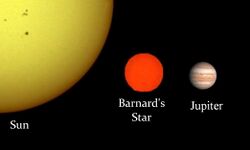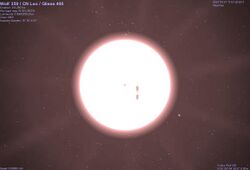Astronomy:Flare star
A flare star is a variable star that can undergo unpredictable dramatic increases in brightness for a few minutes. It is believed that the flares on flare stars are analogous to solar flares in that they are due to the magnetic energy stored in the stars' atmospheres. The brightness increase is across the spectrum, from X-rays to radio waves. Flare activity among late-type stars was first reported by A. van Maanen in 1945, for WX Ursae Majoris and YZ Canis Minoris.[1] However, the best-known flare star is UV Ceti, first observed to flare in 1948. Today similar flare stars are classified as UV Ceti type variable stars (using the abbreviation UV) in variable star catalogs such as the General Catalogue of Variable Stars.
Most flare stars are dim red dwarfs, although recent research indicates that less massive brown dwarfs might also be capable of flaring.[citation needed] The more massive RS Canum Venaticorum variables (RS CVn) are also known to flare, but it is understood that these flares are induced by a companion star in a binary system which causes the magnetic field to become tangled. Additionally, nine stars similar to the Sun had also been seen to undergo flare events[2] prior to the flood of superflare data from the Kepler observatory. It has been proposed that the mechanism for this is similar to that of the RS CVn variables in that the flares are being induced by a companion, namely an unseen Jupiter-like planet in a close orbit.[3]
Nearby flare stars
Flare stars are intrinsically faint, but have been found to distances of 1,000 light years from Earth.[4] On April 23, 2014, NASA's Swift satellite detected the strongest, hottest, and longest-lasting sequence of stellar flares ever seen from a nearby red dwarf, DG Canum Venaticorum. The initial blast from this record-setting series of explosions was as much as 10,000 times more powerful than the largest solar flare ever recorded.[5]
Proxima Centauri

The Sun's nearest stellar neighbor Proxima Centauri is a flare star that undergoes occasional increases in brightness because of magnetic activity.[6] The star's magnetic field is created by convection throughout the stellar body, and the resulting flare activity generates a total X-ray emission similar to that produced by the Sun.[7]
Wolf 359
The flare star Wolf 359 is another near neighbor (2.39 ± 0.01 parsecs). This star, also known as Gliese 406 and CN Leo, is a red dwarf of spectral class M6.5 that emits X-rays.[8] It is a UV Ceti flare star,[9] and has a relatively high flare rate.
The mean magnetic field has a strength of about 2.2 kG (0.2 T), but this varies significantly on time scales as short as six hours.[10] By comparison, the magnetic field of the Sun averages 1 G (100 μT), although it can rise as high as 3 kG (0.3 T) in active sunspot regions.[11]
Barnard's Star

Barnard's Star is the fourth nearest star to the Sun. Given its age, at 7–12 billion years of age, Barnard's Star is considerably older than the Sun. It was long assumed to be quiescent in terms of stellar activity. However, in 1998, astronomers observed an intense stellar flare, showing that Barnard's Star is a flare star.[12][13]
EV Lacertae
EV Lacertae is located 16.5 light-years away, and is the nearest star in its constellation. It is a young star, about 300 million years old, and has a strong magnetic field. In 2008, it produced a record-setting flare that was thousands of times more powerful than the largest observed solar flare.[14]
TVLM513-46546
TVLM 513-46546 is a very low mass M9 flare star, at the boundary between red dwarfs and brown dwarfs. Data from Arecibo Observatory at radio wavelengths determined that the star flares every 7054 s with a precision of one one-hundredth of a second.[15]
2MASS J18352154-3123385 A
The more massive member of the binary star 2MASS J1835, an M6.5 star, has strong X-ray activity indicative of a flare star, although it has never been directly observed to flare.
Record-setting flares
The most powerful stellar flare detected, as of December 2005, may have come from the active binary II Peg.[16] Its observation by Swift suggested the presence of hard X-rays in the well-established Neupert effect as seen in solar flares.
See also
- Astronomy:Solar flare – Eruption of electromagnetic radiation
- Astronomy:Superflare – Strong explosion observed on stars
- Astronomy:Variable star – Star whose brightness fluctuates, as seen from Earth
References
- ↑ "Variable Stars of Low Luminosity". Publications of the Astronomical Society of the Pacific 66 (388): 5. February 1954. doi:10.1086/126639. Bibcode: 1954PASP...66....5J.
- ↑ Schaefer, Bradley E.; King, Jeremy R.; Deliyannis, Constantine P. (February 2000). "Superflares on Ordinary Solar-Type Stars". The Astrophysical Journal 529 (2): 1026. doi:10.1086/308325. Bibcode: 2000ApJ...529.1026S.
- ↑ Rubenstein, Eric; Schaefer, Bradley E. (February 2000). "Are Superflares on Solar Analogues Caused by Extrasolar Planets?". The Astrophysical Journal 529 (2): 1031. doi:10.1086/308326. Bibcode: 2000ApJ...529.1031R.
- ↑ Kulkarni, Shrinivas R.; Rau, Arne (2006). "The Nature of the Deep Lens Survey Fast Transients". Astrophysical Journal 644 (1): L63. doi:10.1086/505423. Bibcode: 2006ApJ...644L..63K.
- ↑ NASA/Goddard Space Flight Center, "NASA's Swift mission observes mega flares from nearby red dwarf star", ScienceDaily, 30 September 2014
- ↑ Christian, Damian J.; Mathioudakis, Michail; Bloomfield, D. Shaun; Dupuis, Jean; Keenan, Francis P. (2004). "A Detailed Study of Opacity in the Upper Atmosphere of Proxima Centauri". Astrophysical Journal 612 (2): 1140–6. doi:10.1086/422803. Bibcode: 2004ApJ...612.1140C.
- ↑ Wood, Brian E.; Linsky, Jeffrey L.; Müller, Hans-Reinhard; Zank, Gary P. (2001). "Observational Estimates for the Mass-Loss Rates of α Centauri and Proxima Centauri Using Hubble Space Telescope Lyα Spectra". Astrophysical Journal 547 (1): L49–L52. doi:10.1086/318888. Bibcode: 2001ApJ...547L..49W.
- ↑ Schmitt, Juergen H. M. M.; Fleming, Thomas A.; Giampapa, Mark S. (September 1995). "The X-Ray View of the Low-Mass Stars in the Solar Neighborhood". Astrophysical Journal 450 (9): 392–400. doi:10.1086/176149. Bibcode: 1995ApJ...450..392S.
- ↑ Gershberg, Roald E.; Shakhovskaia, Nadezhda I. (1983). "Characteristics of activity energetics of the UV Cet-type flare stars". Astrophysics and Space Science 95 (2): 235–53. doi:10.1007/BF00653631. Bibcode: 1983Ap&SS..95..235G.
- ↑ Reiners, Ansgar et al. (2007). "Rapid magnetic flux variability on the flare star CN Leonis". Astronomy and Astrophysics 466 (2): L13–L16. doi:10.1051/0004-6361:20077095. Bibcode: 2007A&A...466L..13R. http://www.aanda.org/index.php?option=com_article&access=standard&Itemid=129&url=/articles/aa/pdf/2007/17/aa7095-07.pdf.
- ↑ "Calling Dr. Frankenstein! : Interactive Binaries Show Signs of Induced Hyperactivity". National Optical Astronomy Observatory. 7 January 2007. http://www.noao.edu/outreach/press/pr07/pr0701.html.
- ↑ Croswell, Ken (November 2005). "A Flare for Barnard's Star". Astronomy Magazine. Kalmbach Publishing Co.. http://www.astronomy.com/news/2005/11/a-flare-for-barnards-star.
- ↑ "V2500 Oph". http://www.aavso.org/vsx/index.php?view=detail.top&oid=22986.
- ↑ "Pipsqueak Star Unleashes Monster Flare". https://www.nasa.gov/image-article/pipsqueak-star-unleashes-monster-flare/.
- ↑ Wolszczan, A.; Route, M. (2014). "Timing Analysis of the Periodic Radio and Optical Brightness Variations of the Ultracool Dwarf, TVLM 513-46546". The Astrophysical Journal 788 (1): 23. doi:10.1088/0004-637X/788/1/23. Bibcode: 2014ApJ...788...23W.
- ↑ Osten, Rachel; Drake, Steve; Tueller, Jack; Cameron, Brian; "Swift Observations of Stellar Flares", Swift Team Meeting, 1 May 2007
External links
- UV Ceti and the flare stars, Autumn 2003 Variable Star Of The Season prepared by Matthew Templeton, AAVSO (www.aavso.org)
- Stellar Flares - D. Montes, UCM.
 |





